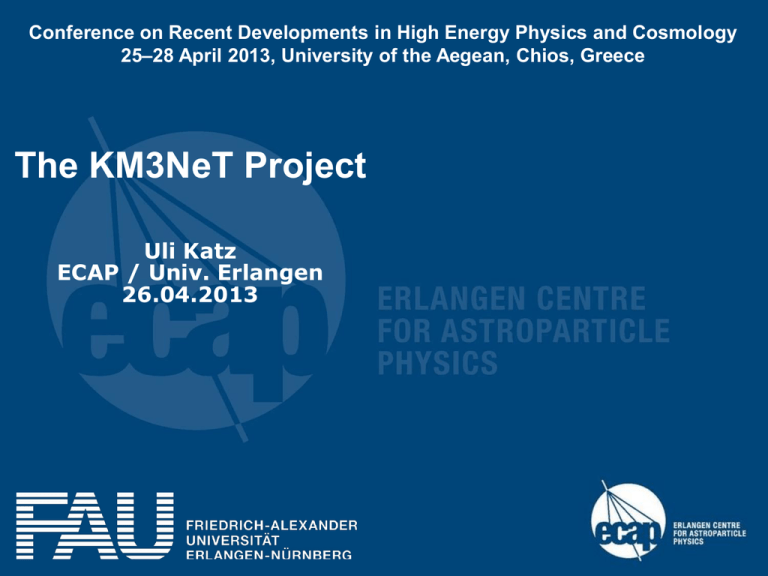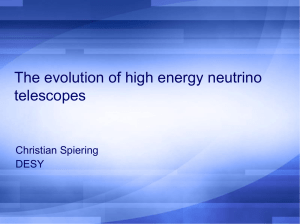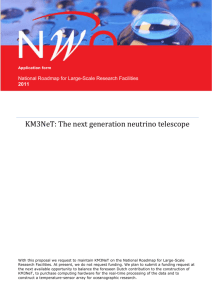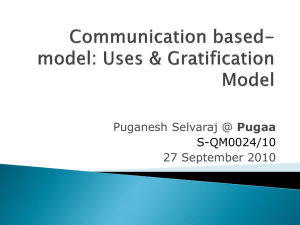10:20-11:00 Uli Katz "The KM3NeT project"
advertisement

Conference on Recent Developments in High Energy Physics and Cosmology 25–28 April 2013, University of the Aegean, Chios, Greece The KM3NeT Project Uli Katz ECAP / Univ. Erlangen 26.04.2013 The plan for the next 40 minutes: • Neutrino telescopes • What is KM3NeT? • Physics prospects with KM3NeT • Recent achievements • Studying low-energy neutrinos: The ORCA option • Summary Sincere thanks to all colleagues who allowed me to use their material U. Katz: The KM3NeT Project, 26.04.2013 2 Neutrino telescopes U. Katz: The KM3NeT Project, 26.04.2013 3 How does a neutrino telescope work? • Neutrino interacts in the (vicinity of the) telescope • Charged secondaries cross the detector volume (water or ice) and stimulate Cherenkov emission • Recorded by a 3D-array of photo-sensors • Most important channel: • Energy range : 10(0) GeV – some PeV U. Katz: The KM3NeT Project, 26.04.2013 4 Backgrounds, or maybe not • Atmospheric neutrinos from cosmicray interactions in atmosphere • irreducible • important calibration source • • • p m NT Earth allow for oscillation studies Atmospheric muons from cosmic-ray interactions in atmosphere above NT • penetrate to NT • exceed neutrino event rate by several orders of magnitude n n Atmosphere p Sea water: light from K40 decays and bioluminescence U. Katz: The KM3NeT Project, 26.04.2013 5 The neutrino telescope world map Lake Baikal DUMAND KM3NeT: onde 3 neutrino A distributed multi-kmsensor (custom-built groups) telescope in the Mediterranean Sea IceCube (South Pole) U. Katz: The KM3NeT Project, 26.04.2013 6 6 Example targets of neutrino astronomy • Galactic neutrino sources • Extragalactic sources • Transient sources • Diffuse neutrino flux • Neutrinos from Dark Matter annihilations • Particle physics with atmospheric neutrinos ExtremelyActive brightGalactic gamma Nuclei ray flash (sec-min) (AGN): Isotropic high-energy neutrino fluxof from hypernovae or BH/NS or galaxy … Super-massive black hole inmergers centre above atmospheric neutrino background Isotropic distribution remnant extragalactic Example: Supernova RX J1713 with accretion disk and jet emission • Search for exotics from unresolved astrophysical sources Gamma observation by H.E.S.S. (monopoles, nuclearites,…) or of cosmogenic origin (GZK) U. Katz: The KM3NeT Project, 26.04.2013 7 South Pole and Mediterranean fields of view Galactic coordinates 2p downward sensitivity assumed > 25% > 75% IceCube @ South Pole: Sees Northern hemisphere U. Katz: The KM3NeT Project, 26.04.2013 8 ANTARES: The first NT in the deep sea • Installed near Toulon at a depth of 2475m • Instrumented volume ~0.01km3 • Data taking in full configuration since 2008 • 12 strings with 25 storeys each • Almost 900 optical modules • Acoustic sensor system U. Katz: The KM3NeT Project, 26.04.2013 9 IceCube: Completed in December 2010 • 86 strings altogether • 125 m horizontal spacing • 17 m vertical distance between Optical Modules • 1 km3 instrumented volume, depth 2450m • Deep Core • densely instrumented region in clearest ice • atmospheric muon veto by IceCube • first Deep Core results • Plan for future low-energy extension (PINGU) U. Katz: The KM3NeT Project, 26.04.2013 10 IceCube: Event skymap (IC40+59+79) preliminary TeV − PeV Northern hemisphere 108,317 events atm. muons atm. neutrinos equatorial coordinates 146,018 events Southern hemisphere ≳ PeV 11 U. Katz: The KM3NeT Project, 26.04.2013 11 atm. muons atm. neutrinos IceCube: Significance map (IC40+59+79) TeV − PeV preliminary DEC = 2.8º ; RA = 34.3º Nsrc = 23.1 p-values: pre-trial = 2×10-5 post-trial = 57% DEC = -38.8º ; RA = 219.3º Nsrc = 20.8 p-values: pre-trial = 9×10-5 post-trial = 98% PeV − EeV 12 U. Katz: The KM3NeT Project, 26.04.2013 12 What is KM3NeT? U. Katz: The KM3NeT Project, 26.04.2013 13 The KM3NeT project • • • • • Multi-km3 NT in Mediterranean Sea, exceeding IceCube substantially in sensitivity Central physics goals (by priority): • Galactic neutrino “point” sources (energy 1-100 TeV) • Extragalactic sources • High-energy diffuse neutrino flux EU-funded Design Study and Preparatory Phase Decisions taken: • Technology: Strings with 18 multi-PMT optical modules • Multi-site installation (France, Greece, Italy) • 6 building blocks of ~115 strings each Collaboration established U. Katz: The KM3NeT Project, 26.04.2013 14 KM3NeT implementation parameters • Staged implementation: Phase-1 in progress, 40 M€ available. • Science potential from very early stage of construction on. • Overall investment ~220 M€. • Operational costs of full detector 4-6 M€ per year (2-3% of capital investment), including electricity, maintenance, computing, data centre and management. • Node for deep-sea research of earth and sea sciences. U. Katz: The KM3NeT Project, 26.04.2013 15 Installation Sites • Locations of the three pilot projects: • • • • • • ANTARES: Toulon NEMO: Capo Passero NESTOR: Pylos Long-term site characterisation measurements performed Political and funding constraints Solution: networked, distributed implementation U. Katz: The KM3NeT Project, 26.04.2013 16 The building block concept • Building block: • • • • 115 detection units Segmentation enforced by technical reasons Sensitivity for muons independent of block size above ~75 strings One block ~ one IceCube Example configuration: 120 DUs, 100m distance on average • Geometry parameters optimised for galactic sources (E cut-off) • Final optimisation in progress U. Katz: The KM3NeT Project, 26.04.2013 17 Detection units: Strings • Mooring line: • Buoy (probably syntactic foam) • 2 Dyneema© ropes (4 mm diameter) • 18 storeys (one OM each), 30-36m distance, 100m anchor-first storey • Electro-optical backbone (VEOC): • • • • Flexible hose ~ 6mm diameter Oil-filled fibres and copper wires At each storey: connection to 1 fibre+2 wires • Break out box with fuses at each storey: One single pressure transition U. Katz: The KM3NeT Project, 26.04.2013 18 OM with many small PMTs • 31 3-inch PMTs in 17-inch glass sphere (cathode area~ 3x10” PMTs) • 19 in lower, 12 in upper hemisphere • Suspended by plastic structure X • 31 PMT bases (total ~140 mW) (D) • Front-end electronics (B,C) • Al cooling shield and stem (A) A • Single penetrator B C • 2mm optical gel • Advantages: • increased photocathode area • 1-vs-2 photo-electron separation better sensitivity to coincidences • directionality U. Katz: The KM3NeT Project, 26.04.2013 C D PMT 19 Readout: time-over-threshold From the analogue signal to time stamped digital data: t1 t2 Time Amplitude … Threshold • Implemented through FPGA on central logic board contained in optical module • All data to shore via optical fibres driven by lasers on shore • Time synchronisation and slow control U. Katz: The KM3NeT Project, 26.04.2013 20 Deployment Strategy • Compact package – deployment – self-unfurling • • • • Eases logistics (in particular in case of several assembly lines) Speeds up and eases deployment; several units can be deployed in one operation Self-unfurling concepts is being thoroughly tested and verified Connection to seabed network by ROV U. Katz: The KM3NeT Project, 26.04.2013 21 Compactifying Strings String rolled up for self-unfurling: U. Katz: The KM3NeT Project, 26.04.2013 22 Physics prospects with KM3NeT U. Katz: The KM3NeT Project, 26.04.2013 23 Angular resolution • Investigate distribution of angle between incoming neutrino and reconstructed muon • Dominated by kinematics up to ~1TeV • Energy resolution ~0.3 in log10(En) if Eµ>1 TeV U. Katz: The KM3NeT Project, 26.04.2013 < 0.1° 24 RX J1713: A prime candidate source H.E.S.S. Collaboration, ICRC 2007 U. Katz: The KM3NeT Project, 26.04.2013 • Shell-type supernova remnant • Compatible with proton acceleration in shock fronts (Fermi mechanism) • Gamma spectrum measured by H.E.S.S. 25 RX J1713: A prime candidate source • Figure of merit (FOM): time to make an observation at 5s with 50% probability • KM3NeT analysis very conservative; ~20% improvement by unbinned analysis • Clear (but flat) optimum in horizontal distance between DUs KM3NeT preliminary (g emission from RX J1713 assumed 100% hadronic) binned unbinned • Further candidate sources with similar or better discovery chances (Vela X, Fermi Bubbles) U. Katz: The KM3NeT Project, 26.04.2013 26 The Fermi bubbles • Two extended regions above/below centre of Galactic plane • Fermi detected hard g emission (E-2) up to 100 GeV • Origin and acceleration mechanisms under debate – if hadronic, hot neutrino source candidate • Could be first source detected by KM3NeT E-2, 30 TeV cut-off expected flux E-2, 100 TeV cut-off E-2, no cut-off 3s @ 50% 5s @ 50% U. Katz: The KM3NeT Project, 26.04.2013 27 Recent achievements U. Katz: The KM3NeT Project, 26.04.2013 28 The preproduction optical module (PPM-DOM) • Fully equipped DOM (31 PMTs + acoustic positioning sensors + time calibration LED beacon) PPM-DOM installed on the instrumentation Line installed on the line of ANTARES deployment ship • Mounted on the instrumentation line of ANTARES • Instrumentation line installed and connected on 16 April 2013 Final integration tests in dedicated dark box • PPM-DOM fully operational and working correctly U. Katz: The KM3NeT Project, 26.04.2013 29 First PPM-DOM data from the deep sea Coincidence rate on 2 adjacent PMTs Coincidence rate PMT efficiencies g Number of Coincident hits Peak position in a DOM g Up to 150 Cherenkov photons per decay time offsets e- (β decay) 40K 40Ca Concentration of 40K is stable (coincidence rate ~5 Hz on adjacent PMTs) U. Katz: The KM3NeT Project, 26.04.2013 30 String deployment tests, April 2013 Deployment and String rolled •up for self-unfurling: unfurling successful • Problems occurred during recovery operations (heavy currents) • Detailed analysis ongoing • Further test necessary U. Katz: The KM3NeT Project, 26.04.2013 31 Tower deployment, Capo Passero, April 2013 Tower with 8 storeys, 4 OMs each (one 10‘-inch PMT per DOM`) U. Katz: The KM3NeT Project, 26.04.2013 32 First data: PMT rates U. Katz: The KM3NeT Project, 26.04.2013 33 Studying low-energy neutrinos: The ORCA option U. Katz: The KM3NeT Project, 26.04.2013 34 Neutrino mass hierarchy • Depending on sign of : “normal hierarchy” or “inverted hierarchy” (NH) (IH) • A fundamental parameter of particle physics! U. Katz: The KM3NeT Project, 26.04.2013 35 Mass hierarchy and atmospheric neutrinos • Determining the sign of Oscillation of • 3-flavour oscillations of requires matter effect. must be involved. in matter: • “Matter resonance” for (maximal mixing, minimal oscillation frequency). This is the case for U. Katz: The KM3NeT Project, 26.04.2013 36 Neutrino oscillations in Earth • Earth density 4-13 g/cm3 • Relevant: U. Katz: The KM3NeT Project, 26.04.2013 37 ORCA: A case study for KM3NeT • Investigated: 50 strings, 20 OMs each • KM3NeT design: 31 3-inch PMTs / OM • 20 m horizontal distance • 6 m vertical distance • Instrumented volume: 1.75 Mton water Note: This is just a (scalable) example configuration U. Katz: The KM3NeT Project, 26.04.2013 38 ORCA: Hardware and construction issues • Use agreed KM3NeT technology; no major modifications required, but cable lengths etc. to be adapted • String length restricted to avoid entanglement due to deep-sea currents • Deployment requires care and studies (operation of deep-sea submersibles (ROVs) between deployed strings is impossible) • New deployment scheme proposed (several strings in one sea operation) • Very tight time constraints due to funding situation U. Katz: The KM3NeT Project, 26.04.2013 39 The major experimental questions • What are the trigger/event selection efficiencies? • How and how efficiently can we separate different event classes? • How can we reconstruct these events and what resolutions can we reach on En and q ? • How can we control the backgrounds? • What are the dominant systematic effects and how can we control them? • What precision of calibration is needed and how can it be achieved? A proposal requires knowing the answers! U. Katz: The KM3NeT Project, 26.04.2013 40 • • • • Isotropic CC events generated Event must be reconstructed as up-going with vertex in instrumented volume Efficiencies determined for two levels of quality cuts No background rejection Meff(Mtons) ORCA reconstruction efficiency U. Katz: The KM3NeT Project, 26.04.2013 events selected with a looser quality cut events selected with a stricter quality cut 41 ORCA energy and zenith resolutions • • reconstructed from track length Shaded region: 16% and 84% quantiles as function of preliminary • events selected with a looser quality cut events selected with a stricter quality cut preliminary U. Katz: The KM3NeT Project, 26.04.2013 • Median of zenith angle difference 42 Results of toy analysis: significance • Experimental determination of mass hierarchy at 4-5s level requires ~20 Mton-years • Improved determination of seems possible U. Katz: The KM3NeT Project, 26.04.2013 43 Summary and outlook U. Katz: The KM3NeT Project, 26.04.2013 44 • ANTARES has demonstrated the feasibility of a deepsea neutrino telescope. • KM3NeT will provide a multi-km3 installation in the Mediterranean Sea sensitive enough to detect Galactic sources and more. • The design process has concluded in an agreed technology (strings with multi-PMT digital OMs). • KM3NeT will be a multi-site installation (France, Greece, Italy). • It will provide nodes for earth/sea sciences. • A first construction phase in underway. • A low-energy option (ORCA) is under investigation. U. Katz: The KM3NeT Project, 26.04.2013 45









